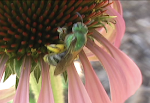There are MANY different ways to help honeybees and native pollinators
B. Decrease Pesticide Use
C. Think of insects as our friends, not our enemies!
A. INCREASE HABITAT
Bees and other pollinators need a variety of flowering plants, shrubs and trees available to them from early spring to late fall. Plant as many "bee-friendly" species as you can.
Plant a Little-leaf Linden tree--"The Bee Tree"!
Let some dandelions and clover grow by raising the mower blade--they are great for bees!
Mow less lawn--let an edge of your lawn grow wild. Species that will grow up there naturally such as berries, mints, milkweed, and goldenrod, are some of the best for bees. Just be sure to remove invasives--they are NOT good for our native insects!
Don't clear out all dead wood and brush, as many species of bees nest in holes in trees or hollow stems of plants. Put up nesting boxes for these bees, that you make or buy. There are also box designs for the ground-nesting bumblebees.
B. DECREASE PESTICIDE USE
Research is showing that beehives are loaded with chemicals. Many garden products contain chemicals that are proven to be toxic to bees. Other chemicals may not be deadly in tests, but could accumulate and work synergistically to impair bee health.
A focus of concern are neoniconitoids, which are found in many garden products--sprays, powders, and liquids--that are sold to control lawn grubs and pests on flowers, fruits, and vegetables. Research is showing the impact of these chemicals on bees may actually increase more than a year after application.
There are numerous library and internet resources about raising a garden or lawn without chemicals. A healthy lawn will discourage grubs. Raise the mower blade, and let clover and grass clippings fertilize naturally.
Fogging your yard to kill mosquitos can kill bees as well, and there are many alternatives. For instance: Apply insecticide to yourself, or wear protective clothing. Empty sources of standing water where mosquitos breed. Cover your rain barrel with a fine-mesh screen. Add a larvicide to kill mosquito larvae in rain barrels and ponds.
Birds and bats eat thousands of insects--put up birdhouses and bathouses to help control insect pests.
C. CHANGE ATTITUDES
America's obsession with the perfect lawn is creating problems for our beneficial insects--think outside the box!
Spread the word to your neighbors about the benefits of increasing habitat and decreasing pesticides. It helps to put up signs that alert others that your "alternative" methods have a purpose.
We may think that pollinator decline is not our problem. But homeowners use up to 10 times more chemical pesticides per acre on their lawns than farmers use on crops. We CAN make a difference.
Some people are allergic to stings, but many of us have an unreasonable fear of insects. Like most insects, pollinators are essential to our world. Tolerate, don't eradicate!
Learn all you can about the decline in pollinators and the latest research on what may be causing it.
Pass along these links to your friends!
This webpage was created to complement the "Pollinator Pyramid" video, produced by In-Site Video, LLC, for Washtenaw County of Ann Arbor, Michigan.
To make suggestions/comments, contact:
Barbara Lucas, at blgreensource(at)gmail.com






